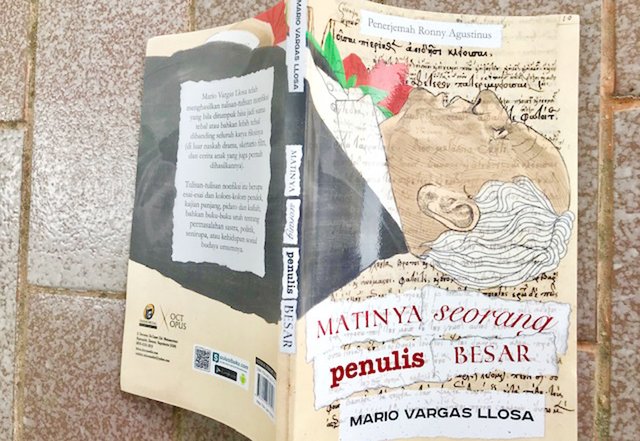Read the Mario Vargas Llosa Phase | Book Review |

Book Data:
Title : Death of a Great Writer (El lenguaje de la pasión)
Author : Mario Vargas Llosa
Publisher : Immortal Publishing
Translator : Ronny Agustinus
First Imprint : 2018
Thickness : x + 140 pages
ISBN : 978-602-6657-94-7
What drives a writer to donate up to 400,000 pounds for an annual literary gift? Perhaps we will regard him as a philanthropist who cares about literature or he wants to pass on his dream to the next generation of writers.
When reviewing the requirements for recipients of literary awards for traditional romantic-themed story writers and under 35 years old, it seems like the last assumption is legitimate even though it is not necessarily close to the truth. The charity, Miss Margaret Elizabeth Trask, has built a thick and high wall of social life, making it difficult to extract any information about the author — even during her lifetime.
Elizabeth Trask—under the pen name Betty Trask—is still a virgin in body and soul until she is 88 years old because she does not build relationships and without social interaction with anyone, except the library guard. Not surprisingly, the association of writers who were trusted to manage the award did not have much information about Betty Trask even though it turned out that the author had given birth to more than 50 romantic stories.
It could be, all his imagination and dreams about romance and romance are contained in his stories and he wants to capture them in the stories of young writers after his life.
Trace of Llosa
The story of Betty Trask is one of 10 short essays written by Maria Vargas Llosa, a writer born in Arequipa, Peru, on March 28, 1938. The nonfiction works of the recipient of the 2010 Nobel Prize for Literature reflects the journey of life from 1967 to 2012, which was chosen selective by translators from the mountainous non-fiction work of Vargas Llosa.
The integrity of the experimental Llosa thinking as assessed by Orhan Pamuk, might be difficult to find in its entirety in this thin book, especially for readers who are not too familiar with the works of Vargas Llosa both fiction and nonfiction.
However, the characteristics of Llosa's socialists are at least seen in the literary essays he wrote in the 1960s, such as his story of resistance through literature with the death of a young man in Castilla as the entrance. Vargas Llosa's political attitude was also seen in Visiting Karl Marx who described sympathetically with the estrem poverty experienced by the Marx family while living on Dean Street, London.
Llosa can describe every detail about the suffering hut of Marx because he lived in London and not just doing a trail to the narrow alleys where Marx spent difficult times. There, Karl Marx's creativity peaked and a number of his eternal works were born. Most of the essays in this book are also written by Llosa in London, the rest in Caracas and Madrid, where he studied at the Complutense University of Madrid.
Llosa could not hide his admiration for Marx having the extraordinary energy to carry out noble and ambitious efforts in difficult situations. It seems that Llosa's view of the commercialization of creative works is more or less influenced by Marx's view that allows writers to make money to be able to live but forbid life and writing to make money (p. 47).
Llosa's attitude in placing literary works at the peak of majesty can be seen in his criticisms of the development of film and television which prioritize commercial and entertainment aspects. According to him, if literature is only seen as entertainment, it will not be able to compete with fiction that invades through film and television.
"Literary works require the active participation of readers through imagination, creativity, memory, association, and intelligence. Film and television marginalize it because of the presence of images that make people lazy and allergic to intellectuals,” critics Llosa. It's criticism does not mean that he is against film and television--of course.
The issue of creativity in literature that is very thick, among others, is discussed in essays written at different phases, such as True Lies (1989), Death of Great Writers (1994) or Literature and Exil (1968). When reading the last essay, the reader will find a similar emotional and psychological atmosphere when reading the novel Pulang (Leila S Chudori in Bahasa) or the book Tanah Air yang Hilang (Martin Aleida) and several other books that discuss the existence even though the times and locations of these books different.
Politics and literature
If the political scent is very thick in this literary essay, it certainly cannot be separated from the background of Llosa who had advanced as Peru's presidential candidate in 1990. His idea of reform in Peru earned him much support to qualify for the second round. However, in the second round he lost to Alberto Fujimori.
Although it is inseparable from political issues, Llosa's writings in the book are not being anesthetized by the reader by the political attitudes of the readers who may be different, a view that can be an example for Indonesian politicians and society in this 2019 political year. If you can take a neutral stance from commercial interests, it is certainly not difficult for Llosa to be the same when literature is dealing with political interests, although in an interview in 2010 Llosa admitted that it was difficult to separate literature from politics.
Despite having produced many works in various forms over the past 60 years of his writing career, there are still a few Vargas Llosa books translated into Bahasa, perhaps because that is why it is difficult to get his books in networked bookstores.
Previously, there were novels of Who’s Killers Palomino Molero (published by Komodo Books, 2012) and other nonfiction writings that were very thin compared to other Nobel-level works, especially from other Latin American writers such as Gabriel Garcia Marquez, Julio Cortazar, or Carlos Fuentes.[]
The review is was published in MAJAS magazine (Indonesia) at the February 2019 edition.





Thanks for using eSteem!
Your post has been voted as a part of eSteem encouragement program. Keep up the good work! Install Android, iOS Mobile app or Windows, Mac, Linux Surfer app, if you haven't already!
Learn more: https://esteem.app
Join our discord: https://discord.gg/8eHupPq
Hello there @ayijufridar. Thanks for your contribution to the realityhubs community. Your contribution qualifies for an upvote from the reality.curate account.
Please read our posting guidelines.
Do you have any questions? Chat with us on Discord
[RealityHubs Moderator]
Thanks so much for your attention @chrisbarth.
Sure 😉
Posted using Partiko Android